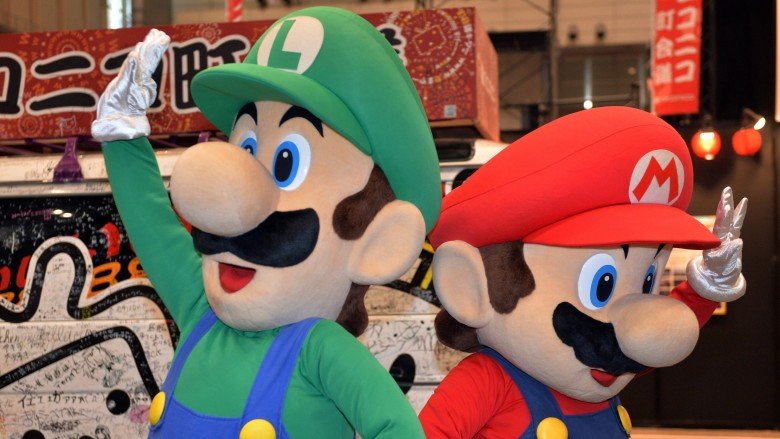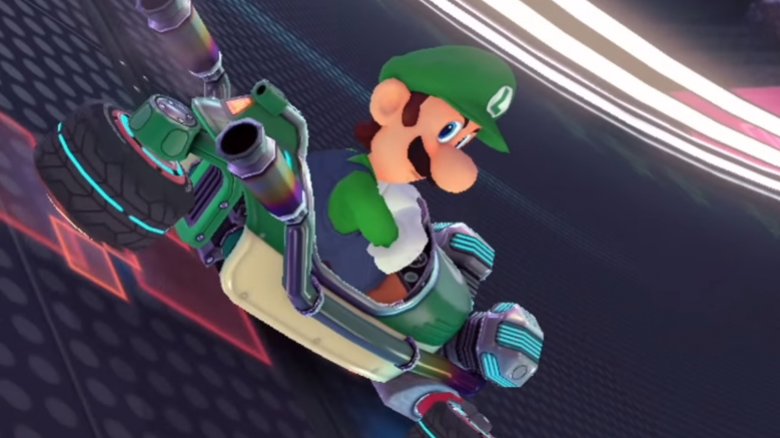False Facts About Mario You Always Thought Were True
Nintendo's iconic Mario is one of the most well-known characters in the world, so of course there are a lot of rumors and myths about the turtle-chucking plumber and his adventures in the Mushroom Kingdom. Below are some Mario-related myths as bustworthy as a star-bearing brick.
Mario breaks blocks with his head
The idea that Mario traipses through the Mushroom Kingdom breaking bricks with his skull is somehow still a popular one, despite Mario's jump sprite in the original Super Mario Bros. clearly showing him punching up with his fist. Comedian and former talk show host Pete Holmes, for example, was responsible for a viral video in 2014 called "What if Mario Hit a Real Brick?" It featured everyone's favorite portly plumber suffering horribly after smacking his noggin on a coin brick. His brother Luigi enters the scene to check up on him, only to make the same tragic mistake, killing him instantly. It sounds horrible, but it's actually extraordinarily well done, and pretty damn funny ... except it doesn't make a lick of sense.
To be fair, we're talking about a game where jumping on turtles makes them retreat into their shells, thus rendering the shell a weapon. These turtles also sometimes fly. There are giant bullets with faces. Mushrooms talk. So the physics of the game — and the biology, anatomy, and chemistry, come to think of it — are not supposed to be realistic. But it's clear the Mario Bros. — especially in later games and promotional art — are punching bricks with their super-punching power, not head-butting bricks with their, um, super-butting power. Let's get real.
Mario and Luigi aren't twins
Starting with Super Mario Bros. 2, Luigi was depicted as the thinner, more athletic of the two titular Mario brothers, leading many to believe he was Mario's younger brother. It didn't help that millions of actual little brothers and sisters were relegated to the Player 2 slot in the original Super Mario Bros., making them play Luigi by default. So Luigi has always been considered the second fiddle, tag-along kid brother character, and he is — but there's more to the story. The Super Mario Bros. are actually the Super Mario Twins.
The bros are indeed fraternal twins, but Mario was born — or at least left the stork's bundle in Super Mario World 2: Yoshi's Island — first, thus subsequent games have mentioned both that they're twins and that Mario is older. It's common, of course, for fraternal twins to make this distinction in real life. If you need further proof, here's an adorable clip of the President of Nintendo, dressed as Luigi, confirming it. You're welcome!
Mario has always been the good guy
Everyone knows that Mario is one of the world's most recognizable heroes, a global do-gooder on par with Mickey Mouse, Superman, Captain America, and Little Caesar. But younger gamers may not know that Mario hasn't always been the good guy. There's one game where Mario was a real bad dude — a proto-Wario, if you will.
In 1982's Donkey Kong, Jr., Mario caged Donkey Kong, Sr. and straight-up tried to murder his kid with deadly traps. It's the only time in gaming history — multiplayer games aside — where Mario is the antagonist. Promo art from the time even gave "Little Mario" a twisty mustache, like he snapped and was going to try to tie Pauline to the train tracks.
Mario flips a switch to make Bowser fall in the lava
In the original Super Mario Bros., Mario finally defeats the real Bowser by sending him plummeting into a moat of molten lava (if he doesn't burn him up using the Fire Flower). He accomplishes this by jumping on an odd-looking, glowing sprite just past Bowser, which then freezes the game for a moment before making the bridge disappear, thus sending the giant turtle to his demise. What many gamers — including the author of this article — didn't realize as kids, is that Mario uses a frickin' axe to cut the ropes to the bridge. It's not a switch, not at all.
Why the confusion? Because Nintendo didn't animate Mario swinging the axe, at all, so it looked like the flashing thingy was actually some kind of switch. Why else would Mario not actually wield the axe thingy? In subsequent Mario games that recycled the use-an-axe-to-cut-the-rope trope, the improved graphics made it clear that it's an axe we're dealing with. In Super Smash Bros. for Wii U, for example, a Kid Icarus character named Viridi makes it crystal clear, saying Mario had to "use an axe to chop a rope bridge and drop the big guy." Sounds exciting! Sure would have been nice to see that, though.
Mario can't jump the flagpoles
Kids in the '80s spent countless hours trying to do everything possible in the original Super Mario Bros., like finding all the warp pipes, getting 99 lives, and scoring 999,999 points. All of those goals, however, were relatively simple compared to the ultimate SMB achievement: jumping over that damned flagpole. Too bad it was impossible, right? The kids on the playground were just making stuff up, right? Right?
Actually, it's totally possible to hop the flagpole in World 3-3, albeit with a very carefully timed jump. You can also pull it off, as the video above details, via a glitch in World 1-1. So what do you get for your feat of Herculean strength and dexterity? Zilch: the other side of the pole, like adulthood, is just an endless void from which you can never return, only finding relief when your time mercifully runs out.
Mario doesn't have a last name
Until 1993's unfortunate Super Mario Bros. movie, the world just assumed that Mario and Luigi were just Mario and Luigi, like how Cher is just Cher. But the film invented the idea that the Mario Brothers are called the Mario Brothers because their last name is, in fact, Mario. This means, in the film at least, Mario is "Mario Mario" and Luigi is "Luigi Mario." Ha! How ridiculous. At least it's not canon, right?
Bad news: In 2015, Mario creator Shigeru Miyamoto confirmed that he retroactively made this canonical, despite claiming in an interview three years prior that "Mario is really just Mario and Luigi is really just Luigi." In 2012, Miyamoto told Game Informer he thought the whole "Mario Mario" idea was hilarious back in the '90s — he said he laughed "rather loudly" upon hearing it. But for some reason, by the 30th anniversary of the original Super Mario Bros. game in 2015, Miyamoto decided he liked it enough to retcon it in. Wait — does this mean Wario is actually "Wario Wario"? And Waluigi is "Waluigi Waluigi"? Or is he "Waluigi Wario?" Hollywood, what hath thou wrought?
Super Mushrooms are based on Alice in Wonderland, or psilocybin mushrooms
In Lewis Carroll's Alice in Wonderland, a shrunken Alice eats a magic mushroom to become a "little larger" because "three inches is such a wretched height to be." Sounds familiar, right? Surely Mario's love of magic Super Mushrooms is inspired by Carroll's tale. Or maybe they're the other kind of "magic" mushrooms and — *bong rip* — Mario is just tripping? Whoa.
Mario creator Shigeru Miyamoto denies the connections, saying the use of mushrooms in the Mario series was inspired instead by "enchanted foodstuffs in myths and folklore." He says there "has always somehow been a relationship between mushrooms and magical realms" and Carroll wasn't an inspiration. As to why the mushrooms run (glide?) away from Mario, that's just because he thought it would be "really fun" to give the player something to chase. And here you thought you were chasing a metaphorical White Rabbit all along! Nope.
Super Mario FX was planned for the SNES
With almost every new Nintendo console, the naming conventions for the games tended to shift to suit the name of the console. So when, say, the Bases Loaded series moved to the Super Nintendo, it became Super Bases Loaded. The Nintendo 64, especially followed this trend, with Super Mario 64, Donkey Kong 64, Star Fox 64, and many more, sometimes leading to nonsensical titles like Shadowgate 64: Trials of the Four Towers. What do you call the sequel to that? Shadowgate 65: Trials of the Eight Towers?
During the Super Nintendo generation, it appeared games utilizing the FX chip, which allowed primitive polygonal 3D graphics, were also going to follow this trend, with Dirt Trax FX and Stunt Race FX. But no, there was never going to be a Super Mario FX, despite what you might have read (or misread) in gaming magazine in the '90s.
As SNES Central outlines, the rumor was apparently born because the chip was codenamed "Super Mario FX" in the early stages, and Mario creator Shigeru Miyamoto once referenced the original Star Fox and the FX chip as an inspiration for Super Mario 64 in an interview with Nintendo Power. That interview was misunderstood and mistranslated over the years, thus spreading the idea of an abandoned "Super Mario FX" game. Too bad, because Mario with FX effects sounds tastier than pepperoni pizza.
Luigi is a hidden playable character in Super Mario 64
The rumors that Luigi was somehow a playable character in Super Mario 64 was the new "You can totally jump the flagpole!" when the game dropped with the Nintendo 64 in 1996. N64.com, in fact, even offered readers $100 if they proved that Mario's twin was accessible. Nintendo muddied the waters a bit in 2004 when they remade the game as Super Mario 64 DS and did, in fact, make Luigi playable. So it's easy to see how gamers today could misremember, Mandela Effect-style.
But no, Luigi was never an option in the original game. There were a ton of amazingly ridiculous fake methods circulating, however, including one gem that trolled kids into swimming 64 times clockwise and 64 times counterclockwise around four sunken chests, just to unlock him. Just imagine the calluses!
Mario is dying on the cover of the original Super Mario Bros.
The cover of the original Super Mario Bros. depicts Mario in his Fire Suit, jumping through one of Bowser's fire-and-stone-filled castles. In 2011, a Reddit user named Deluxo pointed out that the composition sure looks a lot like Mario was falling hopelessly into a lava pit. The observation was picked up by Kotaku, The Escapist, and several other gaming sites, prompting macabre headlines like "Mario Was Dead Before He Hit the NES."
Could Nintendo have intended to depict Mario's horrific death? Or is it just a case of the cover designer taking artistic license for the sake of a cool background? Believe it or not, Mario creator Shigeru Miyamoto actually addressed this silliness in 2015, simply shaking his head "No" at an on-screen prompt of the question in a Twitter video debunking Mario myths. Well, that was simple! Now if only someone could explain the baffling cover art for Phalanx on the SNES, we'd have all our childhood mysteries solved at long last.

